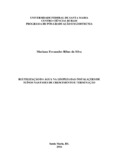Mostrar el registro sencillo del ítem
Reutilização da água na limpeza das instalações de suínos nas fases de crescimento e terminação
| dc.creator | Silva, Mariana Fernandes Ribas da | |
| dc.date.accessioned | 2021-10-07T14:37:09Z | |
| dc.date.available | 2021-10-07T14:37:09Z | |
| dc.date.issued | 2016-03-17 | |
| dc.identifier.uri | http://repositorio.ufsm.br/handle/1/22351 | |
| dc.description.abstract | This study had the purpose to test a system for reuse from the pig farming water. It evaluated the growth performance of animals subjected to cleaning the installations wastewater from swine, they were also evaluated the chemical quality, physical and biochemistry of wastewater and waste. The survey was conducted in the swine sector UFSM, we used 72 pigs, with initial and final weight of 18kg and 115kg respectively, distributed in two treatments (T1- cleaning the stalls with wastewater from swine; T2 pen cleaning with water from the artesian well) the phases of growing and finishing. Analysis of variance was performed and the results obtained, when significant, were submitted to the Student t test to compare means, using the SAS statistical program. Production indices were similar for both treatments (P> 0.05), demonstrating that the treatment system used did not affect the performance of the animals during the study period. The proposed waste treatment system met the objective of the work, because the wastewater obtained no influence on the performance of pigs. The main trace mineral supplements for pigs in growing and finishing Cu, Fe, Mn and Zn obtained a reduction in wastewater by 45%, 73%, 48% and 81% respectively in the growth phase. In the finishing phase Cu reduced 65%, Fe 72%, 70% Mn and Zn 30%. The DQO reduced 81% and 90% in the growing and finishing phases, respectively. The DBO got 38% reduction in the growth phase and 91% in the finishing phase. The pH values were similar between treatments in both phases. | eng |
| dc.description.sponsorship | Coordenação de Aperfeiçoamento de Pessoal de Nível Superior - CAPES | por |
| dc.language | por | por |
| dc.publisher | Universidade Federal de Santa Maria | por |
| dc.rights | Attribution-NonCommercial-NoDerivatives 4.0 International | * |
| dc.rights.uri | http://creativecommons.org/licenses/by-nc-nd/4.0/ | * |
| dc.subject | Suinocultura | por |
| dc.subject | Reuso de água | por |
| dc.subject | Dejetos | por |
| dc.subject | Pig farming | eng |
| dc.subject | Water reuse | eng |
| dc.subject | Waste | eng |
| dc.title | Reutilização da água na limpeza das instalações de suínos nas fases de crescimento e terminação | por |
| dc.title.alternative | Reuse of water in the cleaning of swine systems stages of growth and termination | eng |
| dc.type | Dissertação | por |
| dc.description.resumo | O presente trabalho teve a finalidade de testar um sistema para reuso da água proveniente da suinocultura. Foi avaliado o desempenho zootécnico dos animais submetidos à limpeza das instalações com água residuária da suinocultura, foram também avaliados a qualidade química, física e bioquímica da água residuária e dos dejetos. A pesquisa foi realizada no setor de Suinocultura da UFSM, foram utilizados 72 suínos, com peso inicial e final de 18kg e 115kg, respectivamente, distribuídos em dois tratamentos (T1- limpeza das baias com água residuária da suinocultura; T2- limpeza das baias com água do poço artesiano) nas fases de crescimento e terminação. Foi realizada análise de variância, sendo que os resultados obtidos, quando significativos, foram submetidos ao teste t de Student para comparação de médias, através do programa estatístico SAS. Os índices zootécnicos foram semelhantes nos dois tratamentos (P>0,05), demonstrando que o sistema de tratamento utilizado não influenciou no desempenho dos animais durante o período estudado. O sistema de tratamento de dejetos proposto atendeu o objetivo do trabalho, pois a água residuária obtida não influenciou no desempenho zootécnico dos suínos. Os principais microminerais suplementados para suínos nas fases de crescimento e terminação Cu, Fe, Mn e Zn obtiveram redução na água residuária de 45%, 73%, 48% e 81% respectivamente na fase de crescimento. Na fase de terminação Cu reduziu 65%, Fe 72%, Mn 70% e Zn 30%. A DQO reduziu 81% e 90% na fase de crescimento e terminação, respectivamente. A DBO obteve redução de 38% na fase de crescimento e 91% na fase de terminação. Os valores de pH foram semelhantes entre os tratamentos nas duas fases. | por |
| dc.contributor.advisor1 | Garcia, Gerson Guarez | |
| dc.contributor.advisor1Lattes | http://lattes.cnpq.br/3650864127902483 | por |
| dc.contributor.referee1 | Rosa, Alexandre Pires | |
| dc.contributor.referee2 | Lehnen, Cheila Roberta | |
| dc.creator.Lattes | http://lattes.cnpq.br/4337845217554927 | por |
| dc.publisher.country | Brasil | por |
| dc.publisher.department | Zootecnia | por |
| dc.publisher.initials | UFSM | por |
| dc.publisher.program | Programa de Pós-Graduação em Zootecnia | por |
| dc.subject.cnpq | CNPQ::CIENCIAS AGRARIAS::ZOOTECNIA | por |
| dc.publisher.unidade | Centro de Ciências Rurais | por |
Ficheros en el ítem
Este ítem aparece en la(s) siguiente(s) colección(ones)
-
Programa de Pós-Graduação em Zootecnia [357]
Coleção de dissertações do Programa de Pós-Graduação em Zootecnia



